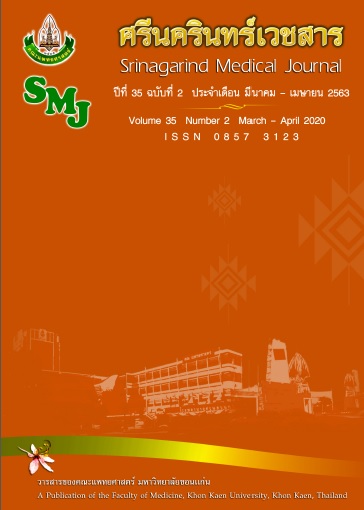Outcome of Anaphylaxis Protocol at Emergency Department, Srinagarind Hospital
Keywords:
แอนาฟิแล็กซิส, ระเบียบการรักษาภาวะแอนาฟิแล็กซิสอย่างเป็นระบบ, แผนกอุบัติเหตุและฉุกเฉิน, Anaphylaxis, Anaphylaxis protocol, Emergency departmentAbstract
ผลของการใช้ระเบียบการรักษาภาวะแอนาฟิแล็กซิสที่แผนกฉุกเฉิน โรงพยาบาลศรีนครินทร์
กมลวรรณ เอี้ยงฮง*, วลัญช์รัตน์ แสงพนัสธาดา, กรกฏ อภิรัตนวรากุล, วัชระ รัตนสีหา, มธุรส บูรณศักดา
โครงการจัดตั้งภาควิชาเวชศาสตร์ฉุกเฉิน คณะแพทยศาสตร์ มหาวิทยาลัยขอนแก่น
หลักการและวัตถุประสงค์: ภาวะแอนาฟิแล็กซิส (anaphylaxis) เป็นภาวะอันตราย การไม่ได้ตระหนักถึงการวินิจฉัยที่ถูกต้องหรือการรักษาไม่ได้มาตรฐานส่งผลให้ผู้ป่วยเสียชีวิตได้ ทางโรงพยาบาลจึงจัดทำระเบียบการรักษาภาวะแอนาฟิแล็กซิสอย่างเป็นระบบ เพื่อให้ผู้ป่วยได้รับการรักษาที่ได้มาตราฐาน การศึกษานี้เพื่อศึกษาร้อยละของผู้ป่วยที่ได้รับยาอะดรีนาลีน (adrenaline) วิธีการให้ยาอะดรีนาลีน รวมถึง ระยะเวลาที่ได้รับยา และเวลาของการรักษาที่ห้องฉุกเฉินภายหลังการใช้ระเบียบการรักษา
วิธีการศึกษา: เป็นการศึกษาเชิงพรรณนาแบบติดตามเก็บข้อมูลย้อนหลังจากเวชระเบียน ในผู้ป่วยที่เข้ารับการรักษาที่ห้องฉุกเฉินโรงพยาบาลศรีนครินทร์ด้วยภาวะแอนาฟิแล็กซิส ในช่วงตั้งแต่วันที่ 1 มกราคม พ.ศ.2557 ถึง 31 ธันวาคม พ.ศ. 2558
ผลการศึกษา: จากผู้ป่วยทั้งหมด 136,226 ราย มีผู้ป่วยที่ทำการศึกษา 174 ราย พบว่า ใช้ระเบียบการรักษาภาวะแอนาฟิแล็กซิส 99 ราย (ร้อยละ56.9) และไม่ใช้ระเบียบการรักษา 75 ราย (ร้อยละ43.1) โดยทั้งสองกลุ่มได้รับการรักษาด้วยยาอะดรีนาลีนร้อยละ 100 วิธีการให้ยาอะดรีนาลีนผ่านทางกล้ามเนื้อร้อยละ 100 ค่ามัธยฐานเวลาที่ผู้ป่วยได้รับอะดรีนาลีน คือ 12.5 นาที และ 15 นาที เวลาการรักษาที่ห้องฉุกเฉินคือ 53 และ 69 นาที ในกลุ่มที่ใช้และไม่ใช้ระเบียบการรักษาตามลำดับ
สรุป: หลังการใช้ระเบียบการรักษา พบว่า ผู้ป่วยทุกรายได้รับยาอะดรีนาลีนโดยวิธีการให้ยาอะดรีนาลีนผ่านทางกล้ามเนื้อตามมาตรฐานการรักษา ส่วนเวลาที่ได้รับยาอะดรีนาลีน และ เวลาที่ใช้ในการรักษาในห้องฉุกเฉินไม่แตกต่างกันทางสถิติเมื่อเปรียบเทียบกับกลุ่มที่ใช้และไม่ใช้ระเบียบการรักษาในช่วงเวลาเดียวกัน
Background and objective: Anaphylaxis is a serious condition. Under diagnosis or under treatment could lead to mortality. Srinagarind hospital has published protocol for anaphylaxis to improve the quality of treatment. The objective of this study was to determine percentage of patients who get adrenaline injection, route of adrenaline injection, time of adrenaline injection and emergency department length of stay after the anaphylaxis protocol used.
Methods: This was a retrospective descriptive study, with medical record review was conducted. All patients came to emergency room at Srinagarind hospital during January 1st, 2014 and December 31st, 2015 who met criteria for diagnosis of anaphylaxis were included.
Results: From 136,266 visitors, the number of researched patients was 174 which was found with using the protocol for anaphylaxis in 99 cases (56.9%) and without using it in 75 cases (43.1%). All patients in each group (100%) were injected with adrenaline. Route of adrenaline injection was intramuscular injection (100%) The median of time of patients injected adrenaline were 12.5 and 15 minutes and the median of emergency department length of stay time were 53 and 69 minutes in group of the protocol for anaphylaxis usage and unusage, respectively.
Conclusions: After the protocol for anaphylaxis was established, all patients got adrenaline injection by using intramuscular injection as standard treatment. There were no statistical significant difference in time to receive adrenaline and emergency department length of stay when compared the protocol for anaphylaxis usage group with the protocol unusage group.
References
Simons FER, Ardusso LR, Bilò MB, Cardona V, Ebisawa M, El-Gamal YM, et al. International consensus on (ICON) anaphylaxis. World Allergy Organ J 2014; 7: 9.
Simons FER, Ardusso LRF, Dimov V, Ebisawa M, El-Gamal YM, Lockey RF, et al. World Allergy Organization Anaphylaxis Guidelines: 2013 update of the evidence base. Int Arch Allergy Immunol 2013; 162: 193–204.
Ma L, Danoff TM, Borish L. Case fatality and population mortality associated with anaphylaxis in the United States. J Allergy Clin Immunol 2014; 133: 1075–83.
Simons FER, Ardusso LRF, Bilò MB, El-Gamal YM, Ledford DK, Ring J, et al. World allergy organization guidelines for the assessment and management of anaphylaxis. World Allergy Organ J 2011; 4: 13–37.
Simons FER, Ebisawa M, Sanchez-Borges M, Thong BY, Worm M, Tanno LK, et al. 2015 update of the evidence base: World Allergy Organization anaphylaxis guidelines. World Allergy Organ J [Internet]. 2015 Oct 28 [cited Mar 2, 2016]; 8(1). Available from: http://www.ncbi.nlm.nih.gov/pmc/articles/PMC4625730/
Phreawa Thatphet, Kamonwon Ienghong, Dhanu Gaysonsiri, Korakot Apiratwarakul, Wutchara Ruttanaseeha. Anaphylaxis in Emergency room Srinagarind Hospital : A 5-Years Retrospective Study. Srinagarind Med J 2017; 32: 534-41.
Clark S, Camargo CA. Emergency management of food allergy: systems perspective. Curr Opin Allergy Clin Immunol 2005; 5: 293–8.
Sampson HA, Muñoz-Furlong A, Campbell RL, Adkinson NF, Bock SA, Branum A, et al. Second symposium on the definition and management of anaphylaxis: summary report--second National Institute of Allergy and Infectious Disease/Food Allergy and Anaphylaxis Network symposium. Ann Emerg Med 2006; 47: 373–80.
Poachanukoon O, Paopairochanakorn C. Incidence of anaphylaxis in the emergency department: a 1-year study in a university hospital. Asian Pac J Allergy Immunol Launched Allergy Immunol Soc Thail 2006; 24(2–3): 111–6.
Manivannan V, Hess EP, Bellamkonda VR, Nestler DM, Bellolio MF, Hagan JB, et al. A multifaceted intervention for patients with anaphylaxis increases epinephrine use in adult emergency department. J Allergy Clin Immunol Pract 2014; 2: 294–9.
Arroabarren E, Lasa EM, Olaciregui I, Sarasqueta C, Muñoz JA, Pérez-Yarza EG. Improving anaphylaxis management in a pediatric emergency department. Pediatr Allergy Immunol Off Publ Eur Soc Pediatr Allergy Immunol 2011; 22: 708–14.
Smit DV, Cameron PA, Rainer TH. Anaphylaxis presentations to an emergency department in Hong Kong: Incidence and predictors of biphasic reactions. J Emerg Med 2005; 28: 381–8.
Piromrat K, Chinratanapisit S, Trathong S. Anaphylaxis in an emergency department: a 2-year study in a tertiary-care hospital. Asian Pac J Allergy Immunol Launched Allergy Immunol Soc Thail 2008; 26(2–3): 121–8.
Pluemchitmongkhon P. Clinical manifestations of Anaphylaxis at the Emergency Department. Khon Kaen Med J 2011; 35: 36–43.


